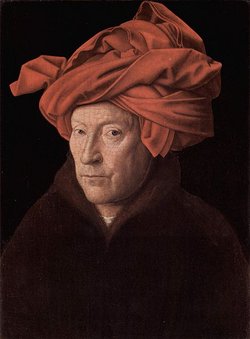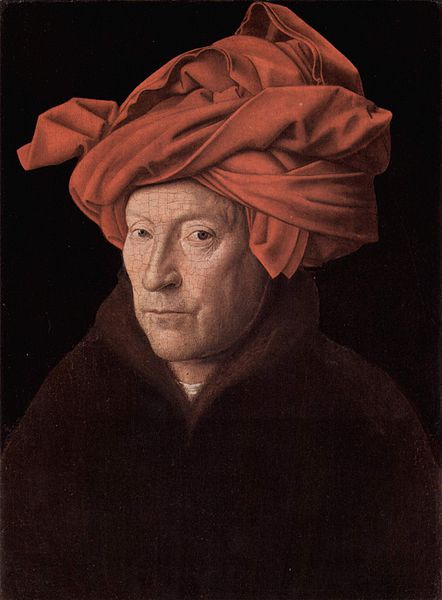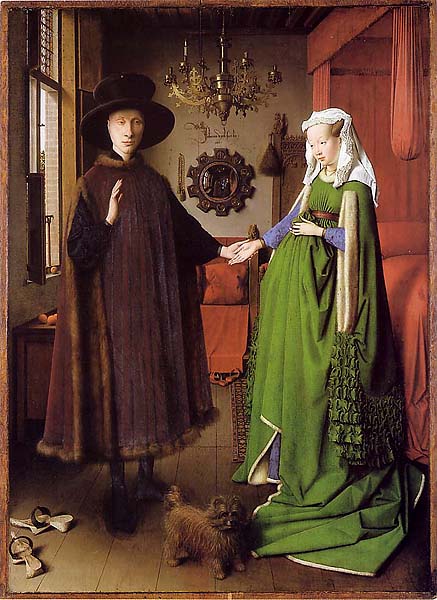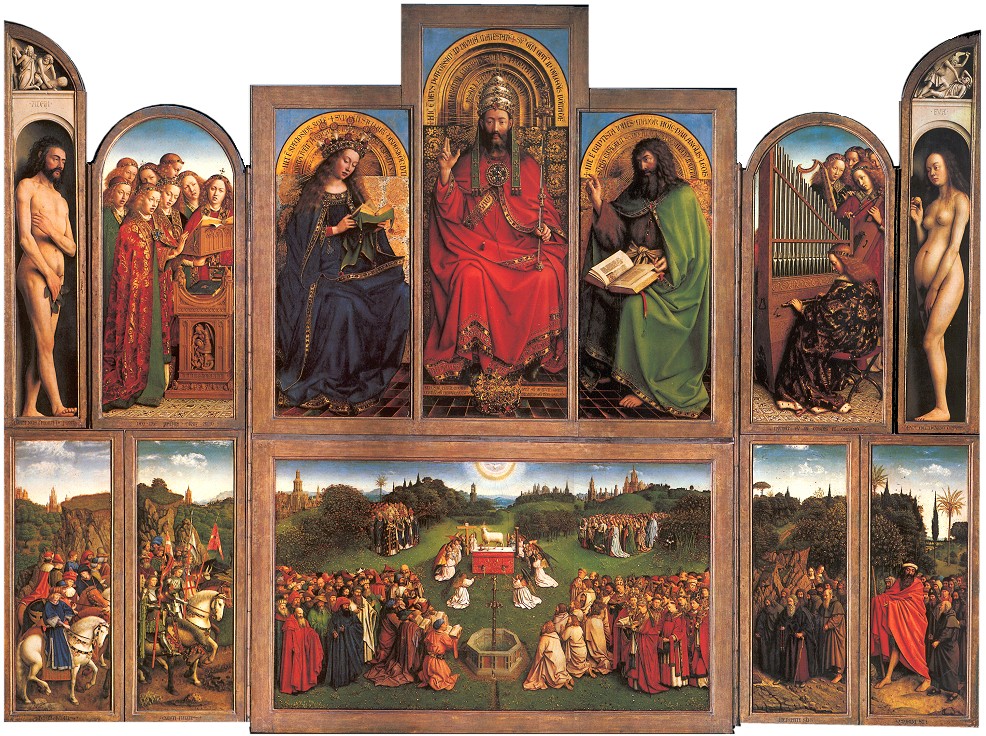Artist. One of the founders of the Flemish school of 15th Century painting, and an acknowledged master of the Renaissance period. Van Eyck was the first important artist to use the new technique of oil painting, which he developed to an exceptional degree of refinement. His style is noted for its complex compositions bathed in natural light, its vibrant color and precise detail, and a blending of realism and symbolism that is formal yet not mannered. He influenced northern European art for over a century. Of Van Eyck's early life nothing is known with certainty. He was the younger brother of painter Hubert Van Eyck and was probably born in the same town, what is now Maaseik, Belgium. The earliest records we have of him are from the court of John of Bavaria at The Hague, where he was employed from roughly 1422 to 1425; he is described as a "Master Painter" with two assistants, so his reputation must have already been considerable. In 1425 he entered the service of Philip the Good, Duke of Burgundy, and the following year settled in Bruges, where he lived the rest of his life. Philip held Van Eyck in great esteem. He made him a Valet of the Chamber and entrusted him with several diplomatic and possible espionage missions. When the Burgundian treasury balked at giving the artist a salary increase, the Duke raged at their stinginess and said he could not afford to have Van Eyck leave, since he would not find another man "his equal in art or science". He even served as godfather to one of the painter's children. Van Eyck died in late June of 1441, and was initially buried at Saint Salvator's Cathedral in Bruges; in March 1442 he was reinterred inside the more prestigious Cathedral of Saint Donatian. This building was destroyed by pro-French Revolutionary mobs in 1799 and no trace of the tomb exists. There is also a cenotaph for him at Saint Bavo's Cathedral in Ghent. Of Van Eyck's 25 surviving paintings, the most famous are "The Adoration of the Mystic Lamb", better known as "The Ghent Altarpiece" (1432), and "The Arnolfini Portrait" (1434). The first is a large and very elaborate altarpiece for St. Bavo's Cathedral, which many consider the greatest work of the Flemish Renaissance. It was originally commissioned from Hubert Van Eyck, who left it unfinished at his death in 1426; Jan stepped in and completed it over a six-year period. Scholars examining its stylistic evidence have been unable to determine where Hubert's efforts broke off and Jan's began. In contrast, "The Arnolfini Portrait" is an intimate interior scene, showing a wealthy couple performing a ceremony before two witnesses who are reflected in a mirror on the rear wall. Its natural light effects were far ahead of their time and cast a luminous glow over the work that centuries have not dimmed. Other notable Van Eyck paintings include "The Madonna" (1432), "The Madonna of Lucca" (c. 1434), "Portrait of Jan de Leewee" (1436), "St. Barbara" (1437), "The Artist's Wife" (1439), and "The Virgin" (1439). He was featured on the Belgian 2020 Commemorative 2 Euro Coin.
Artist. One of the founders of the Flemish school of 15th Century painting, and an acknowledged master of the Renaissance period. Van Eyck was the first important artist to use the new technique of oil painting, which he developed to an exceptional degree of refinement. His style is noted for its complex compositions bathed in natural light, its vibrant color and precise detail, and a blending of realism and symbolism that is formal yet not mannered. He influenced northern European art for over a century. Of Van Eyck's early life nothing is known with certainty. He was the younger brother of painter Hubert Van Eyck and was probably born in the same town, what is now Maaseik, Belgium. The earliest records we have of him are from the court of John of Bavaria at The Hague, where he was employed from roughly 1422 to 1425; he is described as a "Master Painter" with two assistants, so his reputation must have already been considerable. In 1425 he entered the service of Philip the Good, Duke of Burgundy, and the following year settled in Bruges, where he lived the rest of his life. Philip held Van Eyck in great esteem. He made him a Valet of the Chamber and entrusted him with several diplomatic and possible espionage missions. When the Burgundian treasury balked at giving the artist a salary increase, the Duke raged at their stinginess and said he could not afford to have Van Eyck leave, since he would not find another man "his equal in art or science". He even served as godfather to one of the painter's children. Van Eyck died in late June of 1441, and was initially buried at Saint Salvator's Cathedral in Bruges; in March 1442 he was reinterred inside the more prestigious Cathedral of Saint Donatian. This building was destroyed by pro-French Revolutionary mobs in 1799 and no trace of the tomb exists. There is also a cenotaph for him at Saint Bavo's Cathedral in Ghent. Of Van Eyck's 25 surviving paintings, the most famous are "The Adoration of the Mystic Lamb", better known as "The Ghent Altarpiece" (1432), and "The Arnolfini Portrait" (1434). The first is a large and very elaborate altarpiece for St. Bavo's Cathedral, which many consider the greatest work of the Flemish Renaissance. It was originally commissioned from Hubert Van Eyck, who left it unfinished at his death in 1426; Jan stepped in and completed it over a six-year period. Scholars examining its stylistic evidence have been unable to determine where Hubert's efforts broke off and Jan's began. In contrast, "The Arnolfini Portrait" is an intimate interior scene, showing a wealthy couple performing a ceremony before two witnesses who are reflected in a mirror on the rear wall. Its natural light effects were far ahead of their time and cast a luminous glow over the work that centuries have not dimmed. Other notable Van Eyck paintings include "The Madonna" (1432), "The Madonna of Lucca" (c. 1434), "Portrait of Jan de Leewee" (1436), "St. Barbara" (1437), "The Artist's Wife" (1439), and "The Virgin" (1439). He was featured on the Belgian 2020 Commemorative 2 Euro Coin.
Bio by: Bobb Edwards
Advertisement
See more Van Eyck memorials in:
Explore more
Sponsored by Ancestry
Advertisement




